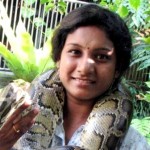 Dr. Manu Anil
Dr. Manu Anil
“You don’t need riches
You don’t need looks
you need n’t have read
A line in books
you don’t need people
you don’t need fame
your dog will love you
just the same
You may lack money
An ugly wight
Without the sense to
Come in at night
You may be ragged
And have no name
Your dog will love you
Just the same.”
Fred B Mann
A dog is considered as a companion animal. Dog was the first animal to be domesticated in different places at the same time and has been the most widely kept working, hunting and pet animal in human history. Hindu mythology unfolds that Lord Dattatreya was the pioneer in the world to rear dog as one of the most faithful bodyguard. King Yudhisthira, during Mahabharatha era seemed to have a dog as pet.
A young pet when cared properly and behaved humanly develops a strong attachment to its master. The social tie with the master is dependent on the age (optimum being 6-8 weeks) of the pet and the degree of isolation from its own species. The dog’s attachment with human is based on care and feed dependencies, so your pet should never be kept in isolation and confinement which will be a dire punishment for it and the consequent reaction will be violence, vocalization and a tendency to escape. The pet’s tolerance and obedience is a result of master’s sympathetic attitude towards it.
SELECTION OF YOUR PUP
While selecting a pup, you should have an idea about the breeds of dog from which you can choose the right one. Factors like availability of space, place of rearing (flat or house) and the people who are going to handle the pet ( children, women ) should be considered before selecting a pup. The pup should be healthy, bright and alert. It should play with its littermates and do not remain drowsy. Response to a stimulus (noise, human contact etc) should be observed to understand the soundness of the animal.
A pup should NOT be purchased before 4-5 weeks. The socialization of a pup actually develops between the ages of 3-14 weeks and it is during this period the pup learns how to interact with its owner, family members and a stranger.
POINTS TO BE REMEMBERED WHILE SELECTING A PUP
The animal should not be too thin or too fatty. Hair of the animal should be glossy and uniformly distributed and should be free from ectoparasites (ticks, lice, fleas etc.). The pup should not be pot-bellied and should be able to move freely and free from any disabilities. There should not be any secretion from nose, ears or eyes and the eyes should be bright and clear. The animal should be free from diseases ( diarrhoea, vomiting, fever etc. ).
COMMON BREEDS OF DOGS
Hound group Gundog group Terrier group
1. Afghan hound 1. English setter 1. Airedale terrier
2. Blood hound 2. Pointer 2. Australian terrier
3. Beagle 3. Retriever 3. Bull terrier
4. Dash hound 4. Labrador 4. Fox terrier
5. Deer hound 5. Cocker spaniel 5. Irish terrier
6. Fox hound 6.Sussex spaniel 6. Scottish terrier
Utility group Working group Toy group
1. Bull dog 1.Alsation 1. Pekingese
2. Chow chow 2. Boxers 2. Pomeranian
3. Dalmation 3. Mastiff 3. Pugs
4. Lhasa apso 4. Collies
5. Poodles 5. Dobermann
6. Boxton terrier 6. Great Dane
DIET AND FEEDING
Meat is the most important component of a dog’s diet. Cooked meat is safe to feed and less likely to cause digestive disorders. Raw meat should NOT be given to your pets since it may contain parasitic worms, toxins, cysts or harmful micro-organisms. Red muscle meat, though deficient in vitamin A and calcium, is an excellent source of good quality protein, appreciable quantity of fat and B vitamins. So bone meal should also be included in the diet as a source of calcium. Liver is a good source of protein, fats and vitamins and is cherished by all dogs. Liver is a storehouse of vitamin A which is essential for dogs. Eggs and cooked fish can also be fed to dogs. Milk is an ideal diet for pups. Commercial baby milk for humans can also be served to pups. Requirement of water for a dog depends on the type of food, environmental temperature, amount of exercise etc. The dog should be provided with adlibitum water.
Milk substitute for pups
(Seek advice of your veterinarian before giving substitutes or supplements.)
Cow milk 500 ml
Water 500ml
Egg yolk 1
Vitamin A 2-3 drops
Vitamin D 2 drops
The above preparation should be warmed to the level of body temperature. For pups up to 3 weeks of age milk should be fed 6 times a day then up to 5 times a day until the pup starts eating solid food.
GENERAL CARE
Exercise is very much essential for a dog to be in perfect health. The confined animals must be given walking or running exercises in open places like garden, park, or an airy room. Regular exercise will help in preventing digestive disturbances.
Brushing or grooming gives the dog a sense of well being. Daily brushing keeps the dog’s coat shining and healthy. It also helps in maintaining cleanliness, removal of ectoparasites, stimulating the sebaceous glands to produce secretion, accustom the dog to regular handling and prevents various skin infections. Careful brushing is necessary for long haired dogs.
All dogs should be washed once or twice in a week in summer and two or three weeks in winter/rainy seasons to keep the hair coat clean, to avoid doggy odor and skin problems. Lukewarm water is preferred for washing. Water should be poured on the body until the coat is wet. Dog soaps or shampoos used should be applied over the coat to form lather all over the body and then thoroughly washed with clean water. Care should be taken to avoid water entering into ear canal. To avoid this, ears may be plugged with cotton during bath. Finally, it should be dried with towel and kept in warm places to make the body dry. Daily washing is NOT advised as it removes natural oil and thus makes the hair coat dull. Never should you use human shampoo or soap especially those containing carbolic acid.
HOUSING
The health and well being of dogs depend to a great extent on the place where they are housed. This should be located in an elevated, well drained sunny place. It should be well built and ventilated. Damp and water logged areas should be avoided. The house should be constructed in south-east direction so as to get adequate sun rays. Kennel door should always open inwards for safety. The size of the kennel depends on the size of the breed and the number of pets to be accommodated. The dog must get ample space to move about freely, turn around and change their position in sleep. Floor should be made of concrete so that cleaning is easy. It should be washed frequently with detergents. The house should be kept insect-free by periodical use of insecticides.
BREEDING
Animal attains puberty at the age of 6-12 months. In smaller breeds the heat may appear for the first time in 6-9 months of age and in larger breeds it might be in 9-12 months. Some breeds (viz. Grey hounds) may require prolonged time up to 22-24 months for the first heat to appear. A well domesticated bitch generally comes into heat twice a year. A bitch should only be allowed to mate during the second heat. The ideal time of mating is 10-14 days from the initial signs of bleeding. The bitch will allow the dog to mate during this period. 2-3 times mating should be allowed during the first 3-4 days of heat. The process of mating should be done in an isolated place free from human interference. The mating process may last for 30-40 minutes. Gestation period of a bitch is 60-64 days.
DEWORMING AND VACCINATION SCHEDULE
The dogs should be dewormed once in a month till 6 months of age and every 6 months till 3 years of age and once in a year thereafter. A deworming record should be maintained.
Date of deworming Anthelmintics used Next due date Signature of veterinarian
Rabies vaccine can be given to dogs at the age of 2 months. If the animal is vaccinated before 3 months of age then a booster dose should be given at 6 months of age and then annual vaccination. If the dog is vaccinated after 6 months of age then booster dose is not required, only annual vaccination is recommended. Multi component vaccine (optional) can be given at the age of 2 months and a booster dose is given after 1 month. Vaccination record should be maintained.
VACCINATION CARD
Name and address of the owner:
Name of animal:
Age:
Sex:
Breed:
Date of vaccination Type of vaccine Batch no and expiry date Route of administration Next due date Signature of veterinarian
Always consult a veterinarian for deworming and vaccination of your pets. Any signs of ill health should be properly attended and the service of a veterinary doctor should be sought.
Every owner should extend love and affection towards their pet. Never ever abandon your pet in disease, disability or debility. Many pets are neglected or abandoned due to a variety of reasons.This is not only a problem of animals but a public health concern. Dogs and cats can transmit diseases to humans and other animals and degrade the environment if they are not properly managed. You should treat them humanly so that you can communicate with them even without words…
The difference between friends and pets is that friends we allow into our company, pets we allow into our solitude – Robert Brault





